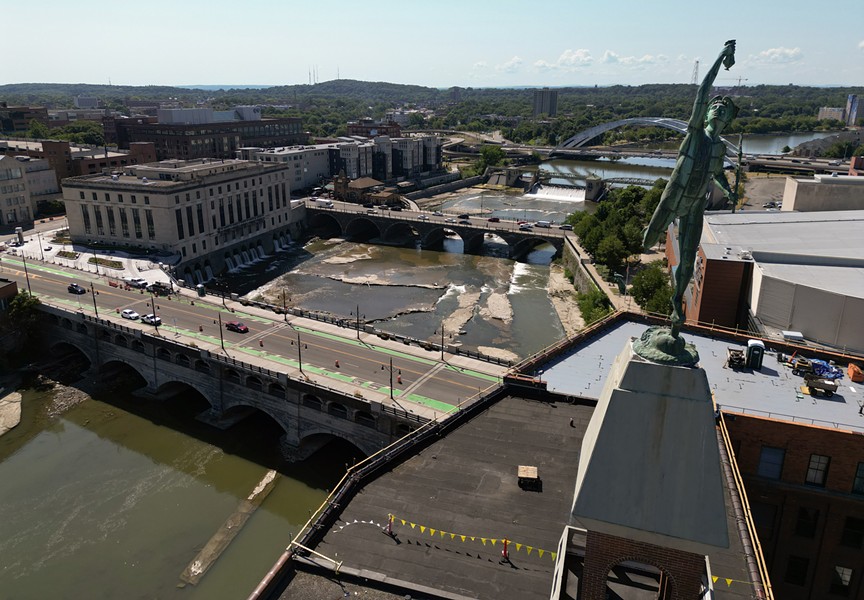It’s a crisp morning and sunlight bursts through the distinctive stone arches of the Broad Street aqueduct, illuminating decades’ worth of graffiti art upon its walls.
The Genesee River roars beneath this cavernous structure in downtown Rochester, which sits unused save for the street artists who paint in the tunnel and the people who use it for shelter.
But a city plan nearly 15 years in the making aspires to turn the aqueduct into a focal point downtown. That plan, dubbed "Aqueduct Reimagined," calls for removing Broad Street from atop the aqueduct and converting what’s left of the structure into a public space.
What it will look like is anyone’s guess. Schematics have been drawn, but what transpires — if anything — is likely to be a hybrid of those designs.
Also anyone’s guess is where the money for the project is going to come from. City officials have estimated that tearing up Broad Street and building something in its place will cost anywhere from $85 million to $110 million.
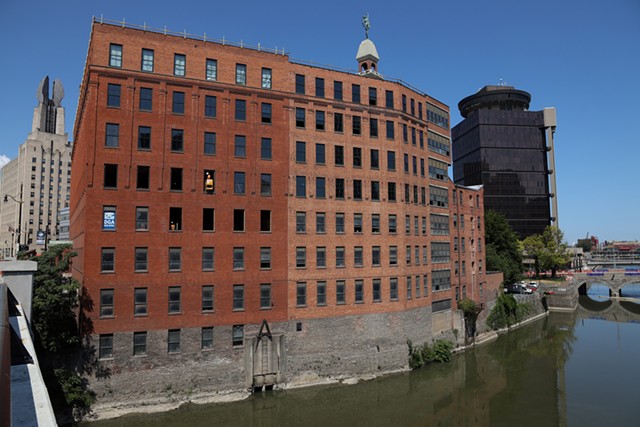 The state has promised the city $9.5 million in funding and the city earmarked $2 million in federal pandemic relief funds for the project. In January, the City Council approved borrowing $500,000 to pay for street improvements around the future home of Constellation Brands, a centerpiece of the reimagined aqueduct.
The state has promised the city $9.5 million in funding and the city earmarked $2 million in federal pandemic relief funds for the project. In January, the City Council approved borrowing $500,000 to pay for street improvements around the future home of Constellation Brands, a centerpiece of the reimagined aqueduct.
That leaves tens of millions of dollars unaccounted for.
“The purpose of the Aqueduct Reimagined project itself is to transform this historic, underutilized piece of transportation infrastructure into this dynamic public space that is unique, and uniquely celebrates Rochester’s history and culture,” said Kamal Crues, ROC the Riverway program manager for the city.
THE AQUEDUCT'S TALE
The Broad Street aqueduct was completed in 1842 as a way for the Erie Canal to flow over and across the Genesee River. It served that purpose until the early 1900s, when the canal was diverted further south.
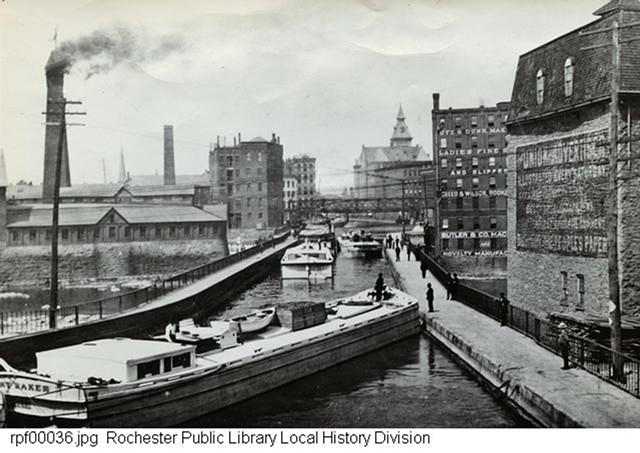 The aqueduct took on a second life as a tunnel for the Rochester subway, which used it from 1927 to 1956. After the commuter train shut down, the railway was still occasionally used for freight deliveries before falling dormant by the end of the 1990s.
The aqueduct took on a second life as a tunnel for the Rochester subway, which used it from 1927 to 1956. After the commuter train shut down, the railway was still occasionally used for freight deliveries before falling dormant by the end of the 1990s.
“There’s a rich layer of history at this site,” Crues said. “If you take a cross-section of this site, you’re taking a cross-section of Rochester’s history.”
City officials floated an early plan for reusing the aqueduct in 2009. At the time, the idea was to pop the top off the Broad Street bridge and fill the remaining channel with water, creating an anchor feature for a so-called “canal district.” That plan never moved forward.
Then, in 2018, former Gov. Andrew Cuomo announced ROC the Riverway, a series of some two-dozen riverfront projects carrying an estimated cost of $500 million, with the state offering $50 million towards the initiative.
The proposal to repurpose the aqueduct became a centerpiece of that initiative, though little progress was made to get it moving in the years following.
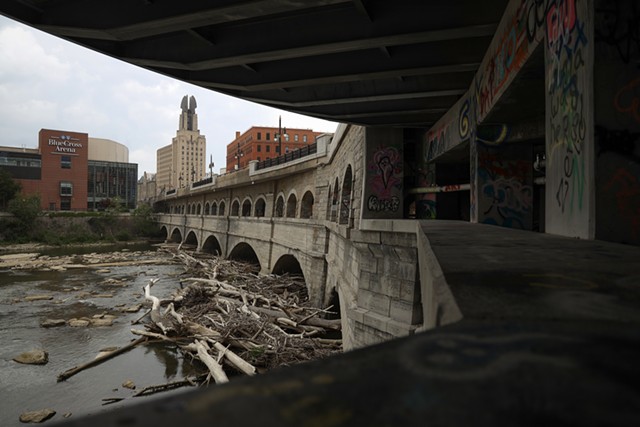 But aspects of the aqueduct project took on new urgency in 2021 when Constellation Brands, the multi-billion dollar beverage conglomerate based in Victor, announced plans to relocate to the Aqueduct Building on Broad Street. The company anticipated bring with it about 340 jobs and creating about 80 new ones.
But aspects of the aqueduct project took on new urgency in 2021 when Constellation Brands, the multi-billion dollar beverage conglomerate based in Victor, announced plans to relocate to the Aqueduct Building on Broad Street. The company anticipated bring with it about 340 jobs and creating about 80 new ones.
Constellation plans to put $50 million into the complex, while the developers who own it plan to invest $30 million.
Meanwhile, the city and state set out to “expedite” Aqueduct Reimagined. Hochul announced that the state would provide the city with a $5 million grant to help cover the cost of relocating utilities infrastructure so that Constellation’s operations wouldn’t be interrupted by future aqueduct construction.
WHEN AND WHY?
In April 2022, Mayor Malik Evans announced a series of public input sessions on Aqueduct Reimagined, officially “launching it,” then released five preliminary mock-ups for what it could look like.
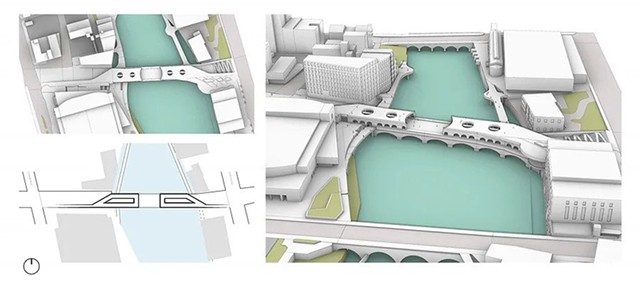 But the city has not selected a concept to advance and observers have said the most likely scenario is that what transpires will be a combination of designs in the mock-ups based on public feedback.
But the city has not selected a concept to advance and observers have said the most likely scenario is that what transpires will be a combination of designs in the mock-ups based on public feedback.
Residents surveyed on the designs preferred those that did two things: Preserved as much of the Broad Street roadway and as much historic architecture as possible.
“Basically what I’m hearing is all the layers of history are important, and worth celebrating,” Crues said.
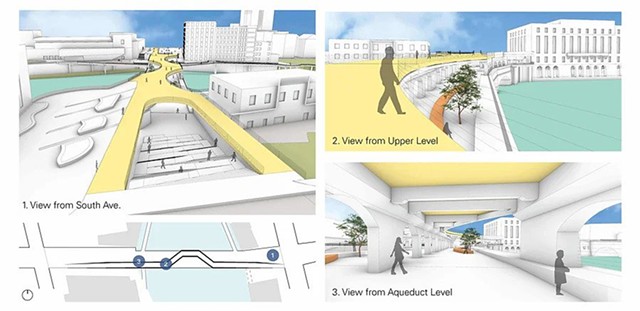 Initial construction on the aqueduct itself isn’t scheduled to start until late 2024. But there’s no set timeline for completion.
Initial construction on the aqueduct itself isn’t scheduled to start until late 2024. But there’s no set timeline for completion.
City Council Vice President Mary Lupien sees the project as an irresponsible undertaking that will likely provide little benefit to the average Rochester resident.
“To me, this is the biggest example of a corporate giveaway I’ve ever seen,” Lupien said in an interview, referring to using federal pandemic relief to complement investments by Constellation. “To spend that amount of money, especially money meant to help our community recover from COVID, on a project like this, when we don’t know if, or when, we will ever get the money to finish the project.”
The ROC the Riverway projects are meant to seamlessly connect the Genesee Riverway to downtown Rochester. Projects like the Brewery Line Trail, renovations at the Riverside Convention Center, and the Roc City Skatepark are elements of ROC the Riverway.
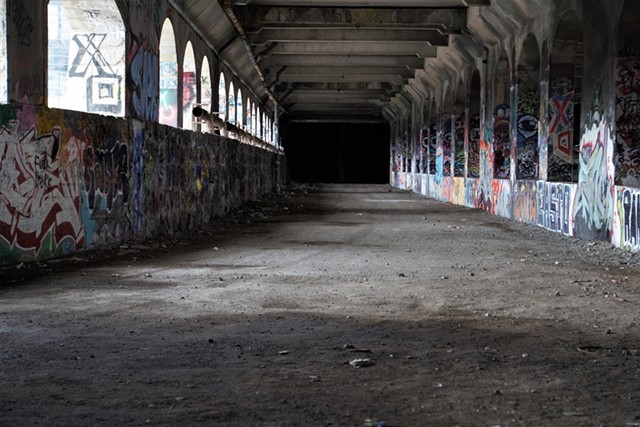 The aqueduct project can “reclaim” a piece of Rochester, said James Dietz, advocacy and outreach manager for Reconnect Rochester, an advocacy group that champions public transit, cycling, and walking.
The aqueduct project can “reclaim” a piece of Rochester, said James Dietz, advocacy and outreach manager for Reconnect Rochester, an advocacy group that champions public transit, cycling, and walking.
“For me, it’s scaling things down away from cars and focusing on people, where people exist, where people aren’t just passing through,” Dietz said. “They’re stopping, they’re enjoying, they’re making memories.”
Mary Staropoli, interim executive director at Reconnect, sees the project as a step toward creating a better environment in downtown Rochester.
“I think this project is all about the pedestrian experience, and creating downtown street life,” Staropoli said. “Filling that in with entertainment, food options, outdoor seating areas, and pedestrian-focused areas, and that’s what this project is.”
Lupien agrees that Rochester is in need of better spaces for pedestrians and cyclists, but she said she is not convinced that repurposing the aqueduct is the best way to do that.
“We need to show data that this works,” Lupien said. “Where is the data that this project will enhance the lives of people in the neighborhood? How will this increase our finances? How will those finances be used?”
There are many hurdles to clear before Aqueduct Reimagined can become a reality. Among them are securing the funding, complying with the State Historic Preservation Office guidelines, and simply finding a final design.
KEEPERS OF THE SUBWAY
Dressed in a maroon puffer jacket and beige Timberland boots, Victor “Range” Zarate sweeps his spray cans across the walls of the subway tunnel, emblazoning the stone with a purple-and-black tag of his moniker.
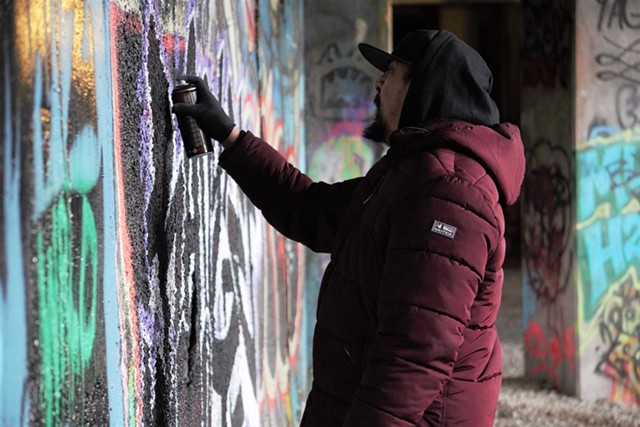 Zarate has been painting in the subways for 30 years alongside his fellow artists in FUA Krew. Getting caught used to be a real risk. Today, authorities tend to look the other way.
Zarate has been painting in the subways for 30 years alongside his fellow artists in FUA Krew. Getting caught used to be a real risk. Today, authorities tend to look the other way.
“We were some of the first ones to start actually doing what we call ‘productions,’ like a whole mural with a background and everything,” Zarate said.
In announcing the launch of the project last year, the mayor said preserving the graffiti was a priority, deferring to local artist Shawn Dunwoody.
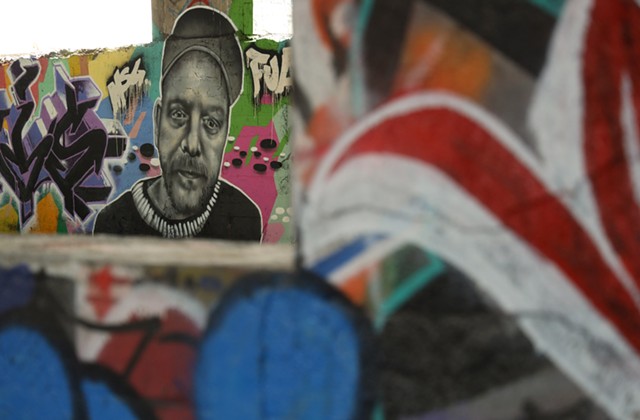 At the time, Dunwoody said he and the city planned to reach out to local graffiti artists for input on the project’s design, such as what pieces in the former subway tunnel could be preserved.
At the time, Dunwoody said he and the city planned to reach out to local graffiti artists for input on the project’s design, such as what pieces in the former subway tunnel could be preserved.
Zarate called the gesture bittersweet, and said he hopes to have a voice in the project if it moves forward.
“The whole art in question, combining the arts into this project, is solely based on the fact that me and my crew made this, gave it artistic appeal from the beginning,” Zarate said. “The only reason we can put art in there is because of what we did before.”
Gino Fanelli is a CITY staff writer. He can be reached at (585) 775-9692 or [email protected].
The Genesee River roars beneath this cavernous structure in downtown Rochester, which sits unused save for the street artists who paint in the tunnel and the people who use it for shelter.
But a city plan nearly 15 years in the making aspires to turn the aqueduct into a focal point downtown. That plan, dubbed "Aqueduct Reimagined," calls for removing Broad Street from atop the aqueduct and converting what’s left of the structure into a public space.
What it will look like is anyone’s guess. Schematics have been drawn, but what transpires — if anything — is likely to be a hybrid of those designs.
Also anyone’s guess is where the money for the project is going to come from. City officials have estimated that tearing up Broad Street and building something in its place will cost anywhere from $85 million to $110 million.

- PHOTO BY MAX SCHULTE
- The Aqueduct Building is to be the new headquarters of Constellation Brands.
That leaves tens of millions of dollars unaccounted for.
“The purpose of the Aqueduct Reimagined project itself is to transform this historic, underutilized piece of transportation infrastructure into this dynamic public space that is unique, and uniquely celebrates Rochester’s history and culture,” said Kamal Crues, ROC the Riverway program manager for the city.
THE AQUEDUCT'S TALE
The Broad Street aqueduct was completed in 1842 as a way for the Erie Canal to flow over and across the Genesee River. It served that purpose until the early 1900s, when the canal was diverted further south.

- ROCHESTER PUBLIC LIBRARY LOCAL HISTORY DIVISION
- The Erie Canal, looking west, circa 1897. The Aqueduct Building is on the right in the middle. Old City Hall is in the distance to the right.
“There’s a rich layer of history at this site,” Crues said. “If you take a cross-section of this site, you’re taking a cross-section of Rochester’s history.”
City officials floated an early plan for reusing the aqueduct in 2009. At the time, the idea was to pop the top off the Broad Street bridge and fill the remaining channel with water, creating an anchor feature for a so-called “canal district.” That plan never moved forward.
Then, in 2018, former Gov. Andrew Cuomo announced ROC the Riverway, a series of some two-dozen riverfront projects carrying an estimated cost of $500 million, with the state offering $50 million towards the initiative.
The proposal to repurpose the aqueduct became a centerpiece of that initiative, though little progress was made to get it moving in the years following.

- PHOTO BY GINO FANELLI
- The Broad Street bridge roadway (top) was built in 1927 to carry motor vehicles over the former aqueduct bed (below). The bed became a subway passage the same year.
Constellation plans to put $50 million into the complex, while the developers who own it plan to invest $30 million.
Meanwhile, the city and state set out to “expedite” Aqueduct Reimagined. Hochul announced that the state would provide the city with a $5 million grant to help cover the cost of relocating utilities infrastructure so that Constellation’s operations wouldn’t be interrupted by future aqueduct construction.
WHEN AND WHY?
In April 2022, Mayor Malik Evans announced a series of public input sessions on Aqueduct Reimagined, officially “launching it,” then released five preliminary mock-ups for what it could look like.

- PROVIDED BY ROCHESTER CITY HALL
- Renderings of what could become of Broad Street bridge.
Residents surveyed on the designs preferred those that did two things: Preserved as much of the Broad Street roadway and as much historic architecture as possible.
“Basically what I’m hearing is all the layers of history are important, and worth celebrating,” Crues said.

- PROVIDED BY ROCHESTER CITY HALL
- Renderings of what could become of Broad Street bridge.
City Council Vice President Mary Lupien sees the project as an irresponsible undertaking that will likely provide little benefit to the average Rochester resident.
“To me, this is the biggest example of a corporate giveaway I’ve ever seen,” Lupien said in an interview, referring to using federal pandemic relief to complement investments by Constellation. “To spend that amount of money, especially money meant to help our community recover from COVID, on a project like this, when we don’t know if, or when, we will ever get the money to finish the project.”
The ROC the Riverway projects are meant to seamlessly connect the Genesee Riverway to downtown Rochester. Projects like the Brewery Line Trail, renovations at the Riverside Convention Center, and the Roc City Skatepark are elements of ROC the Riverway.

- PHOTO BY MAX SCHULTE
- The aqueduct bed sits dormant, save its life as a canvas for graffiti artists.
“For me, it’s scaling things down away from cars and focusing on people, where people exist, where people aren’t just passing through,” Dietz said. “They’re stopping, they’re enjoying, they’re making memories.”
Mary Staropoli, interim executive director at Reconnect, sees the project as a step toward creating a better environment in downtown Rochester.
“I think this project is all about the pedestrian experience, and creating downtown street life,” Staropoli said. “Filling that in with entertainment, food options, outdoor seating areas, and pedestrian-focused areas, and that’s what this project is.”
Lupien agrees that Rochester is in need of better spaces for pedestrians and cyclists, but she said she is not convinced that repurposing the aqueduct is the best way to do that.
“We need to show data that this works,” Lupien said. “Where is the data that this project will enhance the lives of people in the neighborhood? How will this increase our finances? How will those finances be used?”
There are many hurdles to clear before Aqueduct Reimagined can become a reality. Among them are securing the funding, complying with the State Historic Preservation Office guidelines, and simply finding a final design.
KEEPERS OF THE SUBWAY
Dressed in a maroon puffer jacket and beige Timberland boots, Victor “Range” Zarate sweeps his spray cans across the walls of the subway tunnel, emblazoning the stone with a purple-and-black tag of his moniker.

- PHOTO BY GINO FANELLI
- Victor "Range" Zarate has been painting the walls of the aqueduct with his graffiti partners, FUA Krew, for more than 30 years. He believes their work made the aqueduct culturally relevant and hopes to see the art preserved.
“We were some of the first ones to start actually doing what we call ‘productions,’ like a whole mural with a background and everything,” Zarate said.
In announcing the launch of the project last year, the mayor said preserving the graffiti was a priority, deferring to local artist Shawn Dunwoody.

- PHOTO BY MAX SCHULTE
- Artwork in the aqueduct tunnel.
Zarate called the gesture bittersweet, and said he hopes to have a voice in the project if it moves forward.
“The whole art in question, combining the arts into this project, is solely based on the fact that me and my crew made this, gave it artistic appeal from the beginning,” Zarate said. “The only reason we can put art in there is because of what we did before.”
Gino Fanelli is a CITY staff writer. He can be reached at (585) 775-9692 or [email protected].
